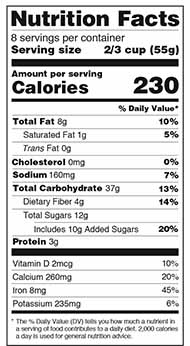On May 20, 2016, the FDA announced the new Nutrition Facts label for packaged foods. Manufacturers are gradually phasing the new format in, as they will need to use the new label by July 26, 2018.

Serving Size
In addition to a larger, bolder font size, serving size data has been updated to reflect something closer to the amount that people actually eat or drink. Products that were previously between serving sizes (for instance, a bottle of soda used to be more than one serving) are now only considered one serving, because it is generally consumed in one sitting. The number of calories per serving got a bigger, bolder typeface too, making it easier to see, even without your reading glasses.
Daily Values
Daily values have been updated for nutrients like sodium, vitamin D and fiber, to reflect the new 2015–2020 Dietary Guidelines for Americans and other expert recommendations.
Added Sugars
New to the label is added sugars (in both grams and %DV), which shows you the amount of non-naturally-occurring sugar added to packaged foods. You likely expect to see added sugar on a soda label, but some foods you think are good for you (like yogurt and oatmeal) have more added sugar than you’d think. Be on the lookout for added sugar in savory packaged foods as well.
Actual Amounts
Nutrients like vitamin D and potassium are now required, to highlight common nutritional deficiencies. Actual amounts in grams as well as %DV are also listed to show exactly how much of a required nutrient your food contains, helping you better understand when supplements are a good idea.
Footnote
And last but not least, a new footnote better explains % Daily Value, simplifying your daily dietary needs.


